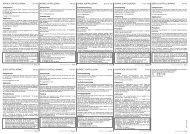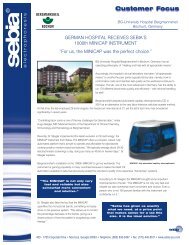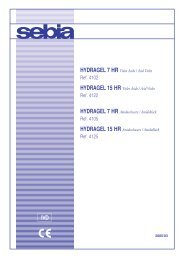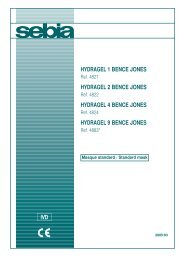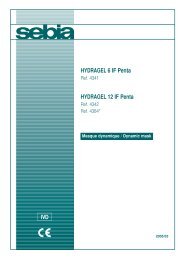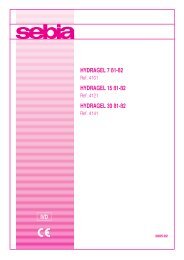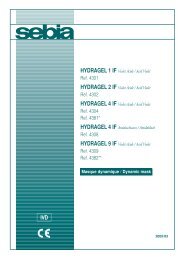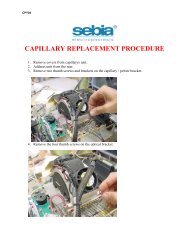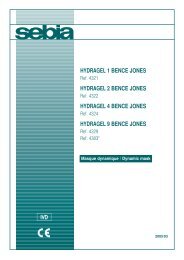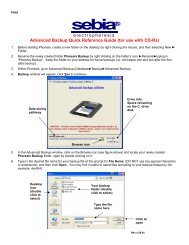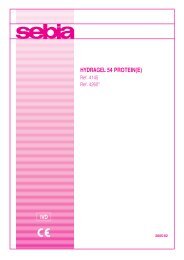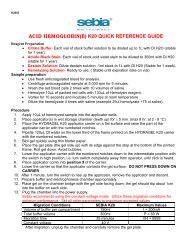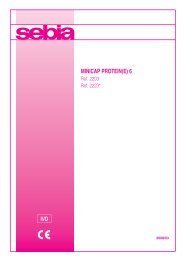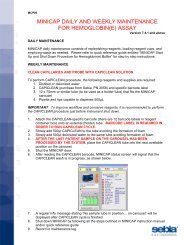HYDRAGEL HEMOGLOBIN(E) K20
HYDRAGEL HEMOGLOBIN(E) K20 - Sebia Electrophoresis
HYDRAGEL HEMOGLOBIN(E) K20 - Sebia Electrophoresis
- No tags were found...
Create successful ePaper yourself
Turn your PDF publications into a flip-book with our unique Google optimized e-Paper software.
<strong>HYDRAGEL</strong> <strong>HEMOGLOBIN</strong>(E) <strong>K20</strong> - 2005/03<br />
INTENDED USE<br />
The <strong>HYDRAGEL</strong> <strong>HEMOGLOBIN</strong>(E) <strong>K20</strong> kit is designed for separation of the normal hemoglobins (A and A 2<br />
) and for the detection of the major<br />
hemoglobin variants: S or D and C or E, by electrophoresis on alkaline agarose gels. The resulting electrophoregrams are evaluated visually for pattern<br />
abnormalities. Densitometry can serve as an aid in the interpretation by providing relative concentrations of individual fractions. Electrophoresis on<br />
acidic gel, e.g., <strong>HYDRAGEL</strong> ACID(E) <strong>HEMOGLOBIN</strong>(E) <strong>K20</strong> procedure, should follow to confirm the identification of hemoglobin variants, in particular,<br />
to differentiate hemoglobins S from D and E from C.<br />
Each agarose gel in the <strong>HYDRAGEL</strong> <strong>HEMOGLOBIN</strong>(E) <strong>K20</strong> kit is intended to run 7 samples.<br />
For In Vitro Diagnostic Use.<br />
PRINCIPLE OF THE TEST<br />
Hemoglobin is a complex molecule composed of two pairs of polypeptide chains. Each chain is linked to the heme, a tetrapyrrolic nucleus (porphyrin)<br />
which chelates an iron atom. The heme part is common to all hemoglobins and their variants. The type of hemoglobin is determined by the protein<br />
part called globin. Polypeptide chains α, ß, δ and γ constitute the normal human hemoglobins:<br />
• hemoglobin A ..................................... = α 2 ß 2<br />
• hemoglobin A 2<br />
.................................... = α 2 δ 2<br />
• fetal hemoglobin F ............................. = α 2 γ 2<br />
The α-chain is common to these three hemoglobins.<br />
The hemoglobin spatial structure and other molecular properties (as that of all proteins) depend on the nature and the sequence of the amino acids<br />
forming the chains. Substitution of amino acids by mutation is responsible for formation of hemoglobin variants which have different surface charge<br />
and consequently different electrophoretic mobilities, which also depend on the pH and ionic strength of the buffer.<br />
The resulting qualitative (or structural) abnormalities are called hemoglobinopathies. Decreased synthesis of one of the hemoglobin chains leads to<br />
quantitative (or regulation) abnormalities, called thalassemias.<br />
The assay is performed on hemolyzed washed red blood cells. The hemoglobins are separated by electrophoresis on alkaline gels and the fractions<br />
are visualized by staining with amidoblack. The dried gels are ready for interpretation.<br />
REAGENTS AND MATERIALS SUPPLIED IN THE <strong>HYDRAGEL</strong> <strong>HEMOGLOBIN</strong>(E) <strong>K20</strong> KIT<br />
ITEMS PN 3010 Agarose Gels (ready to use) 10 gels Tris-Barbital Buffer (stock solution) 3 vials, 75 mL each Staining solution diluent (stock solution) 1 vial, 60 mL Amidoblack Stain (stock solution) 1 vial, 20 mL Destaining Solution (stock solution) 1 vial, 100 mL Hemolysing solution (ready to use) 1 vial, 20 mL Applicators 7 teeth (ready to use) 1 pack of 10<br />
| Filter Papers -Thin | 1 pack of 10 |<br />
FOR OPTIMAL RESULTS<br />
All reagents from the same kit must be always used together and according to the package insert instructions.<br />
PLEASE READ THE PACKAGE INSERT CAREFULLY.<br />
1. AGAROSE GELS<br />
Preparation<br />
Agarose gels are ready to use. Each gel contains: agarose, 0.8 g/dL ; alkaline buffer pH 8.5 ± 0.1 ; additives, nonhazardous at concentrations used,<br />
necessary for optimum performance.<br />
Use<br />
Support medium for hemoglobin electrophoresis.<br />
Storage, stability and signs of deterioration<br />
Store the gels horizontally in the original protective packaging at room temperature (15 to 30 °C) or refrigerated (2 to 8 °C). (The arrow on the front of<br />
the kit box must be pointing upwards). Avoid obvious temperature fluctuations during storage (e.g., do not store close to a window or a heat source).<br />
The gels are stable until the expiration date indicated on the kit package or the gel package labels.<br />
DO NOT FREEZE.<br />
Discard gel when:<br />
(i) crystals or precipitate form on the gel surface or the gel texture becomes very soft (all these result from freezing the gel),<br />
(ii) bacterial or mold growth is indicated,<br />
(iii) abnormal liquid quantity is present in the gel box (as a result of buffer exudation from the gel due to improper storage conditions).<br />
2. TRIS-BARBITAL BUFFER<br />
Preparation<br />
Each vial of the stock buffer solution to be diluted up to 1 liter with distilled or deionized water.<br />
After dilution, the working solution contains : tris-barbital pH 9.2 ± 0.3 ; sodium azide.<br />
WARNING: Each vial of the stock buffer contains 2.45 % barbital, 13.73 % sodium barbital and 0.13 % sodium azide. Do not ingest ! If<br />
ingested, consult physician immediately ! Prevent contact with acids, lead or copper, as these are known to form explosive or toxic<br />
compounds with sodium azide. Always flush with a large quantity of water when disposing.<br />
- 8 -<br />
SEBIA INSTRUCTIONS - English



